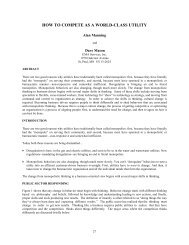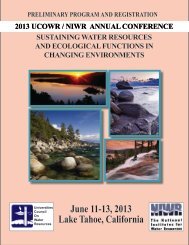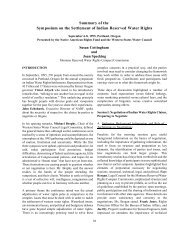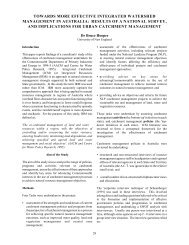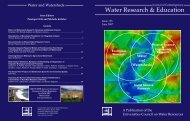60Genskow <strong>and</strong> BornTable 1. <strong>Water</strong>shed examples <strong>of</strong> organizational dynamics.Dungeness River <strong>Water</strong>shed, Washington, USAArea: 300 mi 2Major <strong>Issue</strong>s: <strong>Water</strong> allocation, fisheries, minimum in-stream flows, habitat, water qualityTransitions: Several significant shifts based on planning <strong>and</strong> issue-identification processes. Efforts between 1987<strong>and</strong> 2000 include two incarnations <strong>of</strong> the Dungeness River Management Team (DRMT), a Dungeness River Area<strong>Water</strong>shed Management Committee, the Dungeness-Quilcene Regional Planning Group, the Dungeness RiverRestoration Work Group. DRMT has also served as “lead entity” for additional state-funded habitat protection <strong>and</strong>planning efforts.Precipitators: <strong>Water</strong> use conflict <strong>and</strong> funding opportunities for planning <strong>and</strong> management efforts.Additional Information: Born <strong>and</strong> Genskow 2000Tomorrow-Waupaca River <strong>Water</strong>shed, Wisconsin, USAArea: 290 mi 2Major <strong>Issue</strong>s: Resource protection, ground water qualityTransitions: Citizen initiation <strong>of</strong> a multi-interest Tomorrow-Waupaca <strong>Water</strong>shed Association, which transitionedinto an advisory <strong>and</strong> oversight “steering committee” for a government funded watershed management project.Precipitators: Initial perception <strong>of</strong> threat <strong>and</strong> opportunity for project funding.Additional Information: Born <strong>and</strong> Genskow 2000Yakima River <strong>Water</strong>shed, Washington, USAArea: 6,155 mi 2Major <strong>Issue</strong>s: <strong>Water</strong> allocation/use, fisheries, minimum in-stream flows, water quality.Transitions: Multi-interest initiated watershed council developed consensus plan. Partners secured funding foradditional work through a key partner, which redirected the effort away from the consensus plan <strong>and</strong> disempoweredthe council.Precipitators: <strong>Water</strong> use conflicts <strong>and</strong> recognition <strong>of</strong> threats; funding opportunities.Additional Information: Born <strong>and</strong> Genskow 1999, Genskow 2001, Kent 2004, Woolley <strong>and</strong> McGinnis 1999.process with formal caucus groups representing avariety <strong>of</strong> watershed interests.This series <strong>of</strong> intensive interactions withoverlapping participation led to several importantdevelopments. One <strong>of</strong> the most significant was anagreement between irrigators <strong>and</strong> the WashingtonDepartment <strong>of</strong> Ecology regarding water withdrawals<strong>and</strong> in-stream flows. The agreement, which was laterinstitutionalized through a formal Memor<strong>and</strong>um<strong>of</strong> Underst<strong>and</strong>ing, created trust water rights forthe Dungeness, restored flows to the river, reduceduncertainty regarding tribal claims to in-streamflows, <strong>and</strong> enabled substantial assistance forirrigation efficiency improvements, partly throughfederal habitat improvement grants through thetribal government. The various planning effortsalso led to the creation <strong>of</strong> a river <strong>and</strong> watershededucation center, funded in large part throughprivate donations. Upon completion <strong>of</strong> the state pilotplanning effort, the county <strong>and</strong> tribal governmentsreconstituted the ab<strong>and</strong>oned Dungeness RiverManagement Team to oversee implementation<strong>of</strong> multiple plans <strong>and</strong> coordinate information <strong>and</strong>activities about a wide range <strong>of</strong> issues related to theDungeness River <strong>and</strong> watershed, including salmonrestoration, water quality, ground <strong>and</strong> surface waterflows, development rights, <strong>and</strong> private propertyrights.Tomorrow-WaupacaThe Partnership for the Tomorrow-WaupacaRiver <strong>and</strong> watershed emerged from a large meeting,convened by a private citizen, <strong>of</strong> resource managers,researchers, <strong>and</strong> other citizens with interests in theriver <strong>and</strong> watershed. The individual who initiatedthe meeting was a riparian l<strong>and</strong>owner <strong>and</strong> anglerwho had worked with a local conservation chapter toimprove habitat along stream banks on her property.Interested in working with others in different parts<strong>of</strong> the river, she began a coordination effort forthe river <strong>and</strong> watershed that led to the formation<strong>of</strong> the Tomorrow-Waupaca <strong>Water</strong>shed Association(TWWA), a group comprised <strong>of</strong> interested citizenssupported by a broad base <strong>of</strong> agency <strong>and</strong> researchadvisors. Through the efforts <strong>of</strong> its participants,the partnership transformed from its origins as acitizen-driven non-governmental organizationinto a formal, multi-million-dollar watershedUCOWRJOURNAL OF CONTEMPORARY WATER RESEARCH & EDUCATION
Organizational Dynamics <strong>of</strong> <strong>Water</strong>shed Partnerships61project operated by local government with statefunding, <strong>and</strong> continued oversight from a multiintereststeering committee. Tomorrow-Waupaca<strong>Water</strong>shed Association played an instrumentalrole in the watershed’s selection for a projectaddressing non-point source pollution issues,then effectively disb<strong>and</strong>ed <strong>and</strong> absorbed into theproject’s <strong>of</strong>ficial steering committee. Throughthe project, partners address water quality, leadwatershed <strong>and</strong> conservation educational efforts forkey target audiences, provide financial assistancefor l<strong>and</strong>owners <strong>and</strong> municipalities, monitor <strong>and</strong>research, <strong>and</strong> provide technical assistance. Overtime, as the watershed project has become less <strong>of</strong>a partnership, a new river group has formed to reengagebroad citizen interest.YakimaDuring its four years <strong>of</strong> activity, the YakimaRiver <strong>Water</strong>shed Council (YRWC) was considereda model <strong>of</strong> highly successful, grassroots,collaborative, watershed interaction for the 6,000square mile river basin (Born <strong>and</strong> Genskow 1999,Woolley <strong>and</strong> McGinnis 1999). Within a very shortperiod, the council <strong>and</strong> its related partnershipssuddenly imploded <strong>and</strong> partially reconstituted asa new planning initiative with a reduced set <strong>of</strong>interests. While many individual <strong>and</strong> overlappingefforts continued, the breadth <strong>of</strong> coordinative <strong>and</strong>integrated elements diminished greatly.Yakima River <strong>Water</strong>shed Council formed in1994, following a drought in an irrigation-dependentbasin considered critical to the restoration <strong>of</strong> theColumbia River Basin fishery, with the intention <strong>of</strong>developing <strong>and</strong> implementing a consensus-basedwatershed management plan (Genskow 2001). Thecouncil was inclusive, consensus-driven, <strong>and</strong> servedas a forum for raising <strong>and</strong> debating substantiveissues in watershed management among a broad<strong>and</strong> diverse group <strong>of</strong> interests. Yakima River<strong>Water</strong>shed Council raised more than $600,000 inprivate contributions, supported a four-person staff,engaged more than 100 people on committees thatmet frequently for three years, <strong>and</strong> made significantadvances in generating consensus on recommendedactions for basin water management. As part <strong>of</strong>this process, the Yakima River <strong>Water</strong>shed Councilcatalyzed formation <strong>of</strong> the Tri-County <strong>Water</strong>Resource Agency as an entity to coordinate thethree watershed counties’ interactions with respectto watershed council deliberations <strong>and</strong> to facilitateadoption <strong>of</strong> the Yakima River <strong>Water</strong>shed Councilplan by watershed counties.Toward the end <strong>of</strong> its existence, the YakimaRiver <strong>Water</strong>shed Council worked with Tri-County<strong>and</strong> other partners to successfully secure a sizeable,multi-year planning grant made available througha new state watershed law intended to supportcollaborative efforts such as those in the YakimaRiver <strong>Water</strong>shed. Partners had expected that thefunds would enhance <strong>and</strong> finalize the council’songoing three-year planning efforts <strong>and</strong> movetoward implementation <strong>of</strong> their consensus product.Tri-County was the <strong>of</strong>ficial grant applicant, <strong>and</strong> ina move that surprised most partners, when selectedto receive grant funds, they by-passed the YakimaRiver <strong>Water</strong>shed Council, established a newplanning entity, <strong>and</strong> hired a consultant to begin theplanning process anew. Their decision undercutthe Yakima River <strong>Water</strong>shed Council which,without the expected funds, immediately endedtheir operations. These actions alienated many <strong>of</strong>the key participants who had been active in theYakima River <strong>Water</strong>shed Council efforts, includingleaders from Native American, agribusiness,<strong>and</strong> environmental communities, leading totheir withdrawal from any further collaborativeinteractions. In a very brief period <strong>of</strong> time, thesense <strong>of</strong> trust <strong>and</strong> optimism that had developedthrough the watershed council had evaporated. Afinal plan was released in 2003 without the support<strong>of</strong> key interests. Since its publication <strong>and</strong> the end<strong>of</strong> that planning process, several interests havereconvened in separate initiatives (Kent 2004).These examples illustrate organizational <strong>and</strong>network shifts <strong>and</strong> their various effects. Eachpartnership functioned effectively in terms <strong>of</strong>setting joint priorities <strong>and</strong> taking actions. They allpursued integrated approaches to water resourcemanagement. Each developed networks, trust, <strong>and</strong>reciprocity, thereby creating social capital, whichcan increase or diminish with time (Hutchinson<strong>and</strong> Vidal 2004, Putnam 2000). Each effortproduced one or more plans. However, analysesthat excluded contextual dynamics would havemissed key linkages, <strong>and</strong> may have led to erroneousconclusions about the watershed initiatives. Farfrom the failed effort suggested by demise <strong>of</strong>JOURNAL OF CONTEMPORARY WATER RESEARCH & EDUCATIONUCOWR
- Page 3:
Journal of ContemporaryWater Resear
- Page 6 and 7:
2Bruce Hooperinstitutional, and tem
- Page 11 and 12:
IWRM: Governance, Best Practice, an
- Page 13 and 14: IWRM: Defi nitions and Conceptual M
- Page 15 and 16: IWRM: Defi nitions and Conceptual M
- Page 17 and 18: IWRM: Defi nitions and Conceptual M
- Page 19: IWRM: Defi nitions and Conceptual M
- Page 22 and 23: 18Cardwell. Cole, Cartwright, and M
- Page 24 and 25: 20Mostert26 water boards responsibl
- Page 26 and 27: 22MostertTable 1. Third National Wa
- Page 28 and 29: 24MostertImplementationThe ambitiou
- Page 30 and 31: 26MostertBiswas, A. K. 2004b. Respo
- Page 32 and 33: 28UNIVERSITIES COUNCIL ON WATER RES
- Page 34 and 35: 30Ashton, Turton, and Rouxresource
- Page 36 and 37: 32Ashton, Turton, and Rouxassumptio
- Page 38 and 39: 34Ashton, Turton, and RouxEffective
- Page 40 and 41: 36UNIVERSITIES COUNCIL ON WATER RES
- Page 42 and 43: 38Hussey and Doversin water policy
- Page 44 and 45: 40Hussey and Dovers1994 Council of
- Page 46 and 47: 42Hussey and Doversestablished Thes
- Page 48 and 49: 44Hussey and DoversTable 1. Typolog
- Page 50 and 51: 46Hussey and Doversassessment appro
- Page 52 and 53: 48Hussey and Doverspolicy goals.Bey
- Page 54 and 55: 50Hussey and DoversFrawley, K. 1994
- Page 56 and 57: 52Mitchelloften took three to four
- Page 58 and 59: 54Mitchelltree preservation plans;
- Page 60 and 61: 56UNIVERSITIES COUNCIL ON WATER RES
- Page 62 and 63: 58Genskow and Borna series of chall
- Page 66 and 67: 62Genskow and Bornthe first Dungene
- Page 68 and 69: 64Genskow and BornWashington, DC.Ko
- Page 70 and 71: 66Green and Fernández-BilbaoWithin
- Page 72 and 73: 68Green and Fernández-Bilbaosubjec
- Page 74 and 75: 70Green and Fernández-Bilbaoinflue
- Page 76 and 77: 72Green and Fernández-BilbaoBerbel
- Page 78 and 79: 74UNIVERSITIES COUNCIL ON WATER RES
- Page 80 and 81: 76BallweberEstablish AdvisoryCommit
- Page 82 and 83: 78Ballweberattributes in others (Ch
- Page 84 and 85: 80UNIVERSITIES COUNCIL ON WATER RES
- Page 86 and 87: 82Barreiraand ground water. To this
- Page 88 and 89: 84Barreirawith other states for int
- Page 90 and 91: 86UNIVERSITIES COUNCIL ON WATER RES
- Page 92 and 93: 88Davis and ThrelfallResource Manag
- Page 94 and 95: 90Davis and ThrelfallTable 2. Thirt
- Page 96 and 97: 92Davis and Threlfallby regional an
- Page 98 and 99: 94Davis and Threlfallenforcement, a
- Page 100 and 101: 96Davis and Threlfallhusbandry prac
- Page 102 and 103: 98Davis and ThrelfallNew Zealand: T
- Page 104 and 105: 100UNIVERSITIES COUNCIL ON WATER RE
- Page 106 and 107: 102Lamoree and van SteenbergenIt is
- Page 108 and 109: 104Lamoree and van Steenbergenand n
- Page 110 and 111: 106Lamoree and van Steenbergeninter
- Page 112 and 113: 108BourgetWorks Planner Capability
- Page 114 and 115:
110Bourgetwith over 600 people resp
- Page 116 and 117:
112Bourgetgovernment’s intrusion
- Page 118 and 119:
114Bourget4.management, drought man
- Page 120 and 121:
116McKayFigure 1. The four paradigm
- Page 122 and 123:
118McKay4. Paradigm 4 (which commen
- Page 124 and 125:
120McKaythree main functions:1. ass
- Page 126 and 127:
122McKayState Implementation of the
- Page 128 and 129:
124McKayTable 2. Corporate governan
- Page 130 and 131:
126McKayFigure 4. Qu. 26 - The ESD
- Page 132 and 133:
128McKayFigure 7. Qu.93- This organ
- Page 134 and 135:
130McKayBrundtland Report. 1987. Ou
- Page 136 and 137:
132UCOWR BOARD OF DIRECTORS/COMMITT
- Page 138 and 139:
134BENEFITS OF UCOWR MEMBERSHIPThe
- Page 140 and 141:
136Past Issues of the Journal of Co
- Page 142 and 143:
138Academic Organizations Membershi
- Page 144 and 145:
140Individual Membership Applicatio
- Page 146 and 147:
Universities Council on Water Resou
- Page 148:
Integrated Water Resources Manageme



